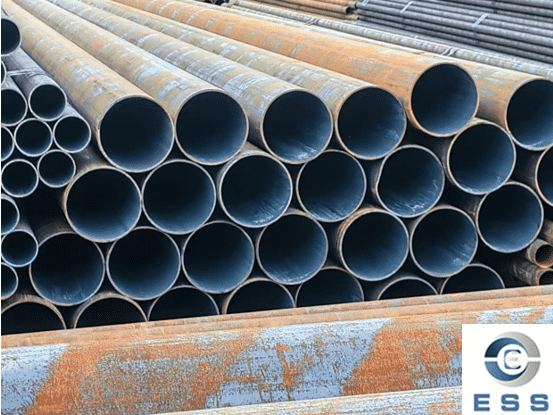Seamless steel pipes are pipelines with a hollow section and are used in large quantities for conveying fluids, such as pipelines for conveying oil, natural gas, gas, water and certain solid materials. Compared with solid steel such as round steel, steel pipe has a lighter weight when the bending and torsion strength is the same. It is a kind of economical cross-section steel and is widely used in pipeline engineering.
The production process of general seamless steel pipes can be divided into two types: cold-rolled and hot-rolled. In appearance, cold-rolled seamless steel pipes are shorter than hot-rolled seamless steel pipes. The wall thickness of cold-rolled seamless steel pipes is generally higher than that of hot-rolled seamless steel pipes. To be small. But the surface looks brighter than thick-walled seamless steel pipes. There is not much roughness on the surface, and there are not too many burrs on the caliber.
The maximum nominal diameter of cold rolled pipe is 200 mm, and the maximum nominal diameter of hot rolled pipe is 600 mm.
Cold rolled steel tube mill
Steel pipe cold processing methods include cold rolling, cold drawing and spinning, which are mainly used to produce small diameter, precision, thin-walled and high-strength pipes. Cold-rolled steel pipes have smooth surface, accurate size, good performance, multiple cross-section shapes, and high metal utilization. They are widely used in defense industry, machinery, mining, chemical, electric power, agricultural machinery and other fields. The cold-rolled steel pipe process is developed on the basis of the cold-drawn steel pipe process. It solves the problems of small deformation in cold drawing passes, multiple passes, high metal consumption and poor deformation conditions.
Cold rolled seamless steel pipe process
The main advantage of cold-rolled steel pipe is the large reduction rate of section, especially the strong wall reduction ability. For carbon steel, the reduction rate of cross-section in one rolling can reach 80%~83%, and for alloy steel it can reach 72%~75%. The main disadvantage is the difficulty of tool replacement. The cold rolling method is often used in combination with the cold drawing method to produce cold-drawn billets, in addition to being directly used to produce some of the cold-rolled pipes with higher precision. This can not only give full play to the wall reduction ability of cold rolling, but also cleverly use the advantages of easy replacement of cold drawn tools, which is conducive to improving productivity, expanding product production range and improving the surface quality of steel pipes.
At present, the production of cold-rolled pipes mostly uses periodic cold-rolled pipe mills. The working feature of the periodic cold rolling pipe mill is that the steel pipe and the mandrel do not move, and the reciprocating motion of the rack drives the reciprocating rolling steel pipe, and uses variable-section-shaped compression rolling parts to achieve the purpose of diameter reduction and wall reduction.

When the mill and roll are at the original position a, the pass size is the largest (slightly larger than the outer diameter of the blank); when the stroke limit position b is reached, the pass is slightly larger than the outer diameter of the finished product; before the position b is reached, the pass size is The smallest is equal to the outer diameter of the finished product. At the original position a, the pipe material is fed in, depending on the size of the rolling mill, each feeding is 3-30mm. At position b, the tube material is turned over 60°~90° each time, so that the pipe wall can be smoothed when the roller returns. After returning to the original position a, feed the tube material to start the next cycle of rolling. The pipe material is rolled repeatedly in this way, and finally the cold-rolled steel pipe of the required size is rolled.
The product specification range of cold-rolled steel pipe is: outer diameter 4.0~450mm; wall thickness 0.04~60mm. Compared with the cold drawing method, the periodic cold-rolled tube method has the advantages of large pass area shrinkage, no difficulty, and high yield: the disadvantage is that the production speed is slow, the tool cost is expensive, and the intermediate processing cost is just high. This method is used to produce stainless steel pipes.
Note
The cold working methods of steel pipes mainly include cold drawing and cold rolling. In recent years, with the development of science and technology, a cold spinning method has been developed. This method can be used to produce large-diameter, high-precision cold-rolled tubes and variable-section cold-rolled tubes. The raw material of cold-worked steel pipes can be hot-rolled seamless steel pipes or welded pipes. The common characteristics of the cold working method of steel pipes are high dimensional accuracy and good surface roughness. It can produce extremely thin (up to 0.05~0.01mm) thin-walled tubes and extremely thin (up to 0.3~0.1 mm in diameter) capillary tubes.













 Eastern Steel Manufacturing Co.,Ltd not only improve product production and sales services, but also provide additional value-added services. As long as you need, we can complete your specific needs together.
Eastern Steel Manufacturing Co.,Ltd not only improve product production and sales services, but also provide additional value-added services. As long as you need, we can complete your specific needs together.










